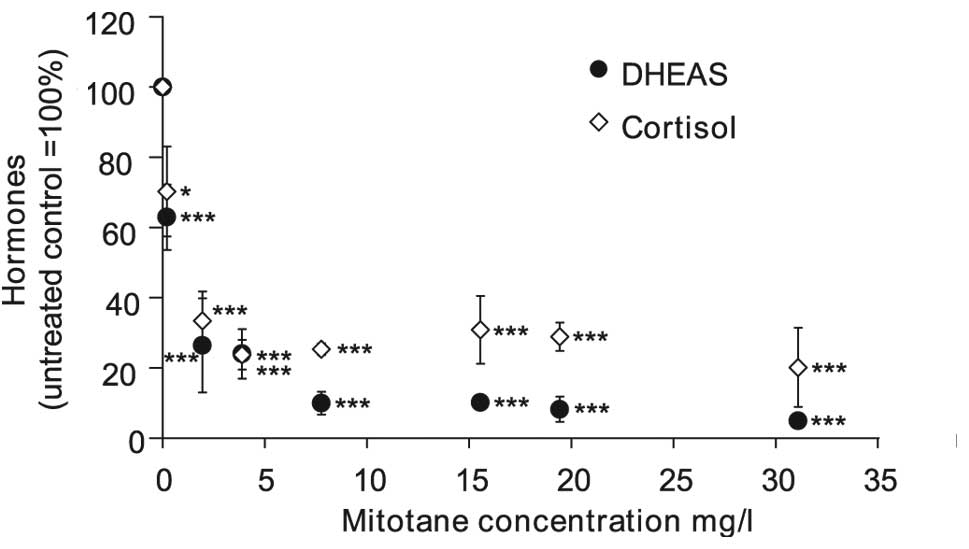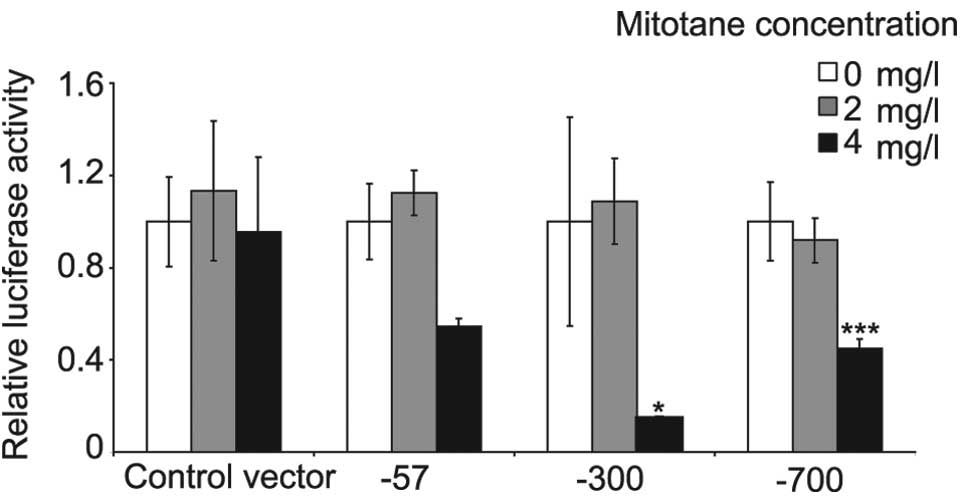|
1
|
Hahner S and Fassnacht M: Mitotane for
adrenocortical carcinoma treatment. Curr Opin Investig Drugs.
6:386–394. 2005.PubMed/NCBI
|
|
2
|
Huang H and Fojo T: Adjuvant mitotane for
adrenocortical cancer - a recurring controversy. J Clin Endocrinol
Metab. 93:3730–3732. 2008. View Article : Google Scholar : PubMed/NCBI
|
|
3
|
Hermsen IG, Fassnacht M, Terzolo M,
Houterman S, den Hartigh J, Leboulleux S, Daffara F, Berruti A,
Chadarevian R, Schlumberger M, Allolio B, Haak HR and Baudin E:
Plasma concentrations of o,p'DDD, o,p'DDA and o,p'DDE as predictors
of tumor response to mitotane in adrenocortical carcinoma: results
of a retrospective ENS@T multicenter study. J Clin Endocrinol
Metab. 96:1844–1851. 2011.
|
|
4
|
Allolio B and Fassnacht M: Clinical
review: Adrenocortical carcinoma: clinical update. J Clin
Endocrinol Metab. 91:2027–2037. 2006. View Article : Google Scholar : PubMed/NCBI
|
|
5
|
Libe R, Fratticci A and Bertherat J:
Adrenocortical cancer: pathophysiology and clinical management.
Endocr Relat Cancer. 14:13–28. 2007. View Article : Google Scholar : PubMed/NCBI
|
|
6
|
Kirschner LS: Emerging treatment
strategies for adrenocortical carcinoma: a new hope. J Clin
Endocrinol Metab. 91:14–21. 2006. View Article : Google Scholar : PubMed/NCBI
|
|
7
|
Zini L, Porpiglia F and Fassnacht M:
Contemporary management of adrenocortical carcinoma. Eur Urol.
60:1055–1065. 2011. View Article : Google Scholar : PubMed/NCBI
|
|
8
|
Haak HR, Hermans J, van de Velde CJ,
Lentjes EG, Goslings BM, Fleuren GJ and Krans HM: Optimal treatment
of adrenocortical carcinoma with mitotane: results in a consecutive
series of 96 patients. Br J Cancer. 69:947–951. 1994. View Article : Google Scholar : PubMed/NCBI
|
|
9
|
Gicquel C, Bertagna X, Gaston V, Coste J,
Louvel A, Baudin E, Bertherat J, Chapuis Y, Duclos JM, Schlumberger
M, Plouin PF, Luton JP and Le Bouc Y: Molecular markers and
long-term recurrences in a large cohort of patients with sporadic
adrenocortical tumors. Cancer Res. 61:6762–6767. 2001.PubMed/NCBI
|
|
10
|
Ragazzon B, Libe R, Gaujoux S, Assie G,
Fratticci A, Launay P, Clauser E, Bertagna X, Tissier F, de Reynies
A and Bertherat J: Transcriptome analysis reveals that p53 and
{beta}-catenin alterations occur in a group of aggressive
adrenocortical cancers. Cancer Res. 70:8276–8281. 2010.
|
|
11
|
Asp V, Ulleras E, Lindstrom V, Bergstrom
U, Oskarsson A and Brandt I: Biphasic hormonal responses to the
adrenocorticolytic DDT metabolite 3-methylsulfonyl-DDE in human
cells. Toxicol Appl Pharmacol. 242:281–289. 2010. View Article : Google Scholar : PubMed/NCBI
|
|
12
|
Lin CW, Chang YH and Pu HF: Mitotane
exhibits dual effects on steroidogenic enzymes gene transcription
under basal and cAMP-stimulating microenvironments in NCI-H295
cells. Toxicology. 298:14–23. 2012. View Article : Google Scholar : PubMed/NCBI
|
|
13
|
Gilep AA, Sushko TA and Usanov SA: At the
crossroads of steroid hormone biosynthesis: the role, substrate
specificity and evolutionary development of CYP17. Biochim Biophys
Acta. 1814:200–209. 2011. View Article : Google Scholar : PubMed/NCBI
|
|
14
|
Chung BC, Picado-Leonard J, Haniu M,
Bienkowski M, Hall PF, Shively JE and Miller WL: Cytochrome P450c17
(steroid 17 alpha-hydroxylase/17,20 lyase): cloning of human
adrenal and testis cDNAs indicates the same gene is expressed in
both tissues. Proc Natl Acad Sci USA. 84:407–411. 1987. View Article : Google Scholar : PubMed/NCBI
|
|
15
|
Miller WL: Minireview: regulation of
steroidogenesis by electron transfer. Endocrinology. 146:2544–2550.
2005. View Article : Google Scholar : PubMed/NCBI
|
|
16
|
Staels B, Hum DW and Miller WL: Regulation
of steroidogenesis in NCI-H295 cells: a cellular model of the human
fetal adrenal. Mol Endocrinol. 7:423–433. 1993.PubMed/NCBI
|
|
17
|
Ahlman H, Khorram-Manesh A, Jansson S,
Wangberg B, Nilsson O, Jacobsson CE and Lindstedt S: Cytotoxic
treatment of adrenocortical carcinoma. World J Surg. 25:927–933.
2001. View Article : Google Scholar : PubMed/NCBI
|
|
18
|
Pushkarev VM, Tronko ND, Kostyuchenko NN
and Mikosha AS: Effect of o,p'-DDD and Li+ on apoptotic
DNA fragmentation in conventionally normal and tumour tissues of
human adrenal cortex. Ukr Biokhim Zh. 79:44–49. 2007.
|
|
19
|
de Fraipont F, El Atifi M, Cherradi N, Le
Moigne G, Defaye G, Houlgatte R, Bertherat J, Bertagna X, Plouin
PF, Baudin E, Berger F, Gicquel C, Chabre O and Feige JJ: Gene
expression profiling of human adrenocortical tumors using
complementary deoxyribonucleic acid microarrays identifies several
candidate genes as markers of malignancy. J Clin Endocrinol Metab.
90:1819–1829. 2005.
|
|
20
|
Dohna M, Reincke M, Mincheva A, Allolio B,
Solinas-Toldo S and Lichter P: Adrenocortical carcinoma is
characterized by a high frequency of chromosomal gains and
high-level amplifications. Genes Chromosomes Cancer. 28:145–152.
2000. View Article : Google Scholar : PubMed/NCBI
|
|
21
|
Kjellman M, Kallioniemi OP, Karhu R, Hoog
A, Farnebo LO, Auer G, Larsson C and Backdahl M: Genetic
aberrations in adrenocortical tumors detected using comparative
genomic hybridization correlate with tumor size and malignancy.
Cancer Res. 56:4219–4223. 1996.
|
|
22
|
Stephan EA, Chung TH, Grant CS, Kim S, Von
Hoff DD, Trent JM and Demeure MJ: Adrenocortical carcinoma survival
rates correlated to genomic copy number variants. Mol Cancer Ther.
7:425–431. 2008. View Article : Google Scholar : PubMed/NCBI
|
|
23
|
Moore CC, Hum DW and Miller WL:
Identification of positive and negative placenta-specific basal
elements and a cyclic adenosine 3′,5′-monophosphate response
element in the human gene for P450scc. Mol Endocrinol. 6:2045–2058.
1992.PubMed/NCBI
|
|
24
|
Sewer MB, Nguyen VQ, Huang CJ, Tucker PW,
Kagawa N and Waterman MR: Transcriptional activation of human CYP17
in H295R adrenocortical cells depends on complex formation among
p54(nrb)/NonO, protein-associated splicing factor and SF-1, a
complex that also participates in repression of transcription.
Endocrinology. 143:1280–1290. 2002. View Article : Google Scholar
|
|
25
|
Asp V, Lindstrom V, Olsson JA, Bergstrom U
and Brandt I: Cytotoxicity and decreased corticosterone production
in adrenocortical Y-1 cells by 3-methylsulfonyl-DDE and
structurally related molecules. Arch Toxicol. 83:389–396. 2009.
View Article : Google Scholar : PubMed/NCBI
|
|
26
|
Shi YQ, Li HW, Wang YP, Liu CJ and Yang
KD: p,p'-DDE induces apoptosis and mRNA expression of
apoptosis-associated genes in testes of pubertal rats. Environ
Toxicol. Mar 7–2011.(Epub ahead of print).
|
|
27
|
Burow ME, Tang Y, Collins-Burow BM,
Krajewski S, Reed JC, McLachlan JA and Beckman BS: Effects of
environmental estrogens on tumor necrosis factor alpha-mediated
apoptosis in MCF-7 cells. Carcinogenesis. 20:2057–2061. 1999.
View Article : Google Scholar : PubMed/NCBI
|
|
28
|
Boatright KM and Salvesen GS: Mechanisms
of caspase activation. Curr Opin Cell Biol. 15:725–731. 2003.
View Article : Google Scholar : PubMed/NCBI
|
|
29
|
Lakhani SA, Masud A, Kuida K, Porter GA
Jr, Booth CJ, Mehal WZ, Inayat I and Flavell RA: Caspases 3 and 7:
key mediators of mitochondrial events of apoptosis. Science.
311:847–851. 2006. View Article : Google Scholar : PubMed/NCBI
|
|
30
|
Alenzi FQ, Lotfy M and Wyse R: Swords of
cell death: caspase activation and regulation. Asian Pac J Cancer
Prev. 11:271–280. 2010.PubMed/NCBI
|
|
31
|
Fuentes-Prior P and Salvesen GS: The
protein structures that shape caspase activity, specificity,
activation and inhibition. Biochem J. 384:201–232. 2004. View Article : Google Scholar : PubMed/NCBI
|
|
32
|
Hogel H, Rantanen K, Jokilehto T, Grenman
R and Jaakkola PM: Prolyl hydroxylase PHD3 enhances the hypoxic
survival and G1 to S transition of carcinoma cells. PLoS One.
6:e271122011. View Article : Google Scholar : PubMed/NCBI
|
|
33
|
Wilhelm S, Wagner H and Hacker G:
Activation of caspase-3-like enzymes in non-apoptotic T cells. Eur
J Immunol. 28:891–900. 1998. View Article : Google Scholar : PubMed/NCBI
|
|
34
|
Feige JJ, Cochet C and Chambaz EM: Type
beta transforming growth factor is a potent modulator of
differentiated adrenocortical cell functions. Biochem Biophys Res
Commun. 139:693–700. 1986. View Article : Google Scholar : PubMed/NCBI
|
|
35
|
Riopel L, Branchaud CL, Goodyer CG, Adkar
V and Lefebvre Y: Growth-inhibitory effect of TGF-B on human fetal
adrenal cells in primary monolayer culture. J Cell Physiol.
140:233–238. 1989. View Article : Google Scholar : PubMed/NCBI
|
|
36
|
Ragazzon B, Cazabat L, Rizk-Rabin M, Assie
G, Groussin L, Fierrard H, Perlemoine K, Martinez A and Bertherat
J: Inactivation of the Carney complex gene 1 (protein kinase A
regulatory subunit 1A) inhibits SMAD3 expression and TGF
beta-stimulated apoptosis in adrenocortical cells. Cancer Res.
69:7278–7284. 2009. View Article : Google Scholar : PubMed/NCBI
|
|
37
|
Khaidakov M, Szwedo J, Mitra S and Mehta
JL: Angiostatic effects of aspirin in hypoxia-reoxygenation are
linked to modulation of TGFbeta1 signaling. J Cardiovasc Pharmacol
Ther. 16:105–110. 2011. View Article : Google Scholar : PubMed/NCBI
|
|
38
|
Nieminen AI, Partanen JI and Klefstrom J:
c-Myc blazing a trail of death: coupling of the mitochondrial and
death receptor apoptosis pathways by c-Myc. Cell Cycle.
6:2464–2472. 2007. View Article : Google Scholar : PubMed/NCBI
|
|
39
|
Prendergast GC: Mechanisms of apoptosis by
c-Myc. Oncogene. 18:2967–2987. 1999. View Article : Google Scholar : PubMed/NCBI
|
|
40
|
Gartel AL and Tyner AL: The role of the
cyclin-dependent kinase inhibitor p21 in apoptosis. Mol Cancer
Ther. 1:639–649. 2002.PubMed/NCBI
|
|
41
|
Shin H, Lee YS and Lee YC: Sodium
butyrate-induced DAPK-mediated apoptosis in human gastric cancer
cells. Oncol Rep. 27:1111–1115. 2012.PubMed/NCBI
|
|
42
|
Suzuki A, Kawano H, Hayashida M, Hayasaki
Y, Tsutomi Y and Akahane K: Procaspase 3/p21 complex formation to
resist fas-mediated cell death is initiated as a result of the
phosphorylation of p21 by protein kinase A. Cell Death Differ.
7:721–728. 2000. View Article : Google Scholar : PubMed/NCBI
|
|
43
|
Tait SW and Green DR: Mitochondria and
cell death: outer membrane permeabilization and beyond. Nat Rev Mol
Cell Biol. 11:621–632. 2011. View Article : Google Scholar : PubMed/NCBI
|
|
44
|
Chen CW, Hurd C, Vorojeikina DP, Arnold SF
and Notides AC: Transcriptional activation of the human estrogen
receptor by DDT isomers and metabolites in yeast and MCF-7 cells.
Biochem Pharmacol. 53:1161–1172. 1997. View Article : Google Scholar : PubMed/NCBI
|
|
45
|
Gell JS, Oh J, Rainey WE and Carr BR:
Effect of estradiol on DHEAS production in the human adrenocortical
cell line, H295R. J Soc Gynecol Investig. 5:144–148. 1998.
View Article : Google Scholar : PubMed/NCBI
|
|
46
|
Vanttinen T, Liu J, Kuulasmaa T, Kivinen P
and Voutilainen R: Expression of activin/inhibin signaling
components in the human adrenal gland and the effects of activins
and inhibins on adrenocortical steroidogenesis and apoptosis. J
Endocrinol. 178:479–489. 2003. View Article : Google Scholar : PubMed/NCBI
|














